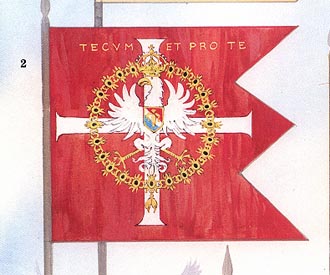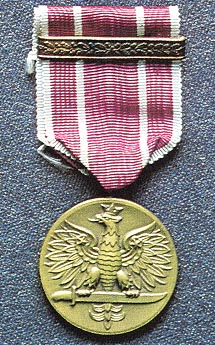
Poland's Military Table of Contents
Written and researched by Margaret Odrowaz-Sypniewska
| The Teutonic Knights and Poland | Malbork-The Castle of the Teutonic Knights | Husaria-The Winged Horsemen | Polish Cossacks |
| Atamans of the Zoporag Cossacks | Polish Horses |

This is the standard of the Cossack troop led by Jan Slawinski, Sword-Bearer of Starodub, Lithuania. It shows the Archangel Michael which is part of the Orthodox religion of Staroduk (near Muscovy) Knight's cross.

This is the banner of the District of Grodno, Lithuania; that was used by General Levy. The rider in the badge is a Vytis (rider) which is one of the symbols of Lithuania.

This is the banner of the Court Army of King Sigismund III (Zygmunt III Waza ... 1566-1632), that was used in Lublin on October 1621, and was carried by the Royal Hussars. Poland's white eagle and wheatsheaf symbolizes the Vasa (Wasa) Family.
King Zygmunt III Waza was the son of King Johann III of Sweden, but he was elected King of Poland in 1587. Around the eagle is a chain of the Golden Fleece. The inscription translates to: "With Thee and For Thee." In 1655, this banner was captured, in Warsaw, by the Swedes and was taken as a military trophy.
Zygmunt III Waza inherited the Swedish throne in 1592, but was deposed because of his strong Roman Catholic views.

The Order of the White Eagle pictured above is from circa 1774. The Order of the White Eagle is the oldest and highest Polish decoration, and one of the most valued in 18th century Europe. It was founded by Augustus II, the Strong, and distributed from about 1795, among persons who rendered service to the king. The decoration was begun in 1713 as a Maltese Cross with red enamel, except for the white edges. Very few of these have survived into modern times. The one pictured above is housed in Wawel Royal Castle Museum in Cracow, Poland

The Virtuti Militari cross was the highest military award for service in field, is bestowed only in wartime. Originally created as a medal in 1792, it was changed to a cross by the King of Poland in 1793. The Virtuti Militaria Order is divided into five (5) classes. The Grand Cross was only awarded to the Commander-in-Chief for winning a war. During World War II, the Polish Armed Forces in Exile awarded no Grand Crosses, but the Polish Communist Government did award thirteen (13) Grand Crosses, with Breast Stars to the Commander-in-Chief of the Polish, U.S., British, French, and Red Armies, between 1945 and 1947 (Kozlowski, M.M.,Poland: Military Medals and Decorations 1935-45. Toronto: Published by author). The version above is the Commander's Cross.
In the book, The Order of the Virtuti Militaria and Its Cavaliers, 1792-1992 by Prof. Zdzislaw P. Wesolowski, it states that After the War of 1920, with the Russians, Ryszard Sypniewski, second Lt. in the 14th Artillery Batallion was awarded the Virtuti Militaria on February 19, 1921. His medal was a Virtuti of the 5th class #1964.

The badge of the Polish Legion. The Legion was established before the war, in 1908, when Josef Pilsudski, a Polish National Leader, founded the "League of Active Struggle." Pilsudski thought that a war between the Great Powers was to occur that Poland would need a Polish independant military force. By the outbreak of the war, Pilsudski had recruited 7,000 armed men, mainly recruited from Austrian Poland, which had been Russian prisoners.
Josef Pilsudski was of szlachta origins and his landed milieu in Lithuania.
On August 2, 1914, Pilsudski's first cavalry patrol crossed the border from Galicia into the Kingdom, followed four days later by a battalion of Riflemen. They occupied Kielce briefly, in the name of Poland, before being forced to withdraw by Russian troops. They confirmed that they would not let the Powers take over Polish territory without a fight.
In July 1917, Pilsudski was arrested. By November 7, 1918 there was a Polish People's Government in Lublin. On November 10, the day before Armistice in the West, Pilsudski was freed from his German jail and arrived in Warsaw. On August 15, 1920, Pilsudski launched a flank attack that virtually annihilated the entire Red Army in Poland.
Poland was independent with 388,600 square kilometers, the sixth largest state in Europe by population. On February 10, 1919, during the first sovereign session of the Polish Seym, Pilsudski said: "a century and a half of battles, sometimes bloody and sacrificial, has found its victory in this day. A century and a half of dreams of a free Poland have come true at the moment."

Related Links:
The Sword, Armour, and Costumes
Polish Military History Books
Lubuske Military Museum in Drzonow, Poland
Last updated on August 6, 2006
© 2000 Maggie973@aol.com
